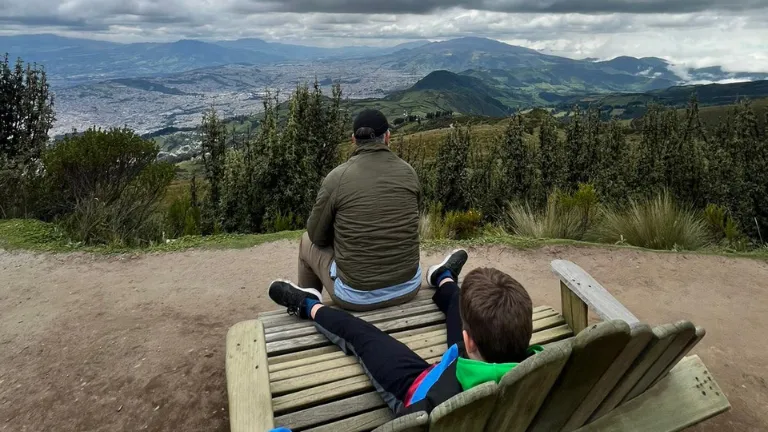What’s Going On in Ecuador?
We’ve mapped out a two-month stay in Ecuador as part of our long-term travels through South and Central America, and it’s safe to say, this country jumped out at us.
It’s not just the dramatic landscapes, think active volcanoes, cloud forests, high-altitude cities, and Pacific beaches, but also the practicality. For families or digital nomads looking to stretch their budget without giving up adventure, Ecuador’s hitting the sweet spot.
Interest is rising fast. Search traffic around Ecuador travel, remote work visas, and long-term living has climbed steadily through 2024, and early 2025 looks like more of the same. Combine that with a relatively stable U.S. dollar economy, and it’s not hard to see why Ecuador is attracting more remote workers, retirees, and travelling families than ever.
Who Ecuador is Perfect For
Ecuador isn’t just for backpackers or luxury hikers heading to the Galápagos. The country works surprisingly well for a broader crowd:
- Budget-conscious travellers who want great value without sacrificing experience
- Remote workers who need solid Wi-Fi and a slower pace of life
- Adventure families who want nature access, city comforts, and manageable distances
Quito and Cuenca offer charming colonial centres, international schools, and a growing expat presence. Smaller towns like Vilcabamba, Loja, and Otavalo appeal to slower travel rhythms, often at half the price.
Many travelers looking for a peaceful getaway filled with culture often turn to Visit Quito for its lively atmosphere and memorable experiences.
There’s a different energy here compared to more polished digital nomad hubs like Costa Rica or Mexico. It’s a bit more raw, but in the best way.
Ecuador’s Appeal in Numbers
Let’s talk logistics, the kind that matter when you’re staying for more than a vacation.
- Cost of Living in Ecuador: Many long-stay travellers report monthly budgets of $1,200–$1,600 for couples or small families, including rent.
- Rent: A modern 2-bedroom apartment in Cuenca or Quito can cost between $400–$700/month.
- Internal Flights: Domestic airfare (e.g., Quito to Cuenca) often runs under $50 USD if booked in advance.
- Transport: Local buses and taxis are cheap. Uber exists in most larger cities.
- Healthcare: Private healthcare is affordable. A doctor’s visit might cost $30–$50, and international insurance plans are widely accepted.
Add in relatively consistent temperatures year-round (thanks to the equator), access to fresh food markets, and a smaller tourist crowd than its neighbours, and Ecuador stands out as a place to live, not just visit.
Culture & Everyday Life
Culture here feels immediate, not packaged for tourists.
Markets buzz with handmade goods and affordable produce. Almuerzos (set lunches) include soup, a main, and juice for about $3 USD. You’ll hear Spanish everywhere, with a slower cadence that’s friendly to learners (which helps if you’re brushing up your Duolingo streak with your kids like we are).
For travelling families, the appeal is layered:
- Local schools and expat homeschooling co-ops in cities like Cuenca
Safe, walkable areas with parks and plazas
- Outdoor activities from ziplining in Mindo to llama spotting in Cotopaxi
We’ve chatted with families based in Vilcabamba who rave about the nature, calm pace, and affordability. In Cuenca, it’s the access to modern amenities and well-organised public spaces that win people over.
That said, there are challenges. Expect more cultural friction than in tourist-slicker areas. But if you’re after an immersive, slower travel rhythm? It delivers.
What It Costs
So how far does your budget go in Ecuador?
We’re planning around $1,500/month for our family of four, though we’ve seen others spend less (or more) depending on travel style.
Here’s what that might include:
- $550–650: 2-bed apartment in Cuenca or Loja
- $300–400: Food (market produce + eating out a few times a week)
- $100–200: Transport, activities, and kid-friendly adventures
- $100–150: Extras like SIM cards, laundry, and gear top-ups
Want a full breakdown?
We put together a detailed guide to the 2025 cost of living in Ecuador, from average monthly rent to the price of an avocado at the market.
Read our full Cost of Living in Ecuador Guide here
Comparing Ecuador to Its Neighbours
One of the most helpful ways to evaluate Ecuador is to stack it against similar destinations in South and Central America.
Compared to Costa Rica, Ecuador is more affordable overall. You’ll get similar biodiversity, mountain-to-coast access, and outdoor adventures, but at a lower cost of rent, food, and transportation. It’s also less saturated with tourists and digital nomads, which can mean more authentic experiences (and fewer overbooked Airbnbs).
Versus Peru, Ecuador can feel more compact and manageable. Travel times between destinations are shorter, and the culture shock can be gentler, especially for families.
And unlike Colombia, Ecuador uses the U.S. dollar, which removes currency fluctuation stress. For travellers managing monthly budgets and affiliate income (like us!), this makes a real difference.
If you’re comparing where to spend a chunk of time on a family sabbatical or remote work stint, Ecuador punches well above its weight in terms of value.
What We’re Planning For
As part of our long-term travel with two young kids, Ecuador is where we’ll slow down. Our plan includes:
- Two weeks in Quito to adjust (and see Cotopaxi up close)
- A month in Cuenca to settle, work remotely, and let the kids find rhythm
- Nature day trips to El Cajas National Park, Mindo Cloud Forest, and possibly the coast
We’ll splurge on decent accommodation and day tours — and save by cooking at home and skipping the Galápagos this time around (for now).
Final Notes: Is Ecuador the Hidden Gem?
Ecuador isn’t the flashiest destination in the region. It doesn’t have Costa Rica’s polished infrastructure or Peru’s Machu Picchu magnetism.
But if you want real cultural experiences, a low cost of living, and one of the most geographically diverse countries in South America, it might just be the gem you’re looking for.
Curious about how far your money goes here? We break it all down in our full cost of living in Ecuador guide, from rent to local markets, and even travel toys for the kids.
A quick heads-up:
- Visa extensions are possible but require planning
- Safety varies by region, stay current on local advisories
- Learning basic Spanish goes a long way (and we’re working on it too)
We’re sharing this as a family about to take the leap, not just from Google searches but from real travel prep. If Ecuador’s on your radar, explore further. Bookmark the guide. Ask the questions.
This is your reminder that slower travel doesn’t have to mean giving up on adventure, or affordability.



































